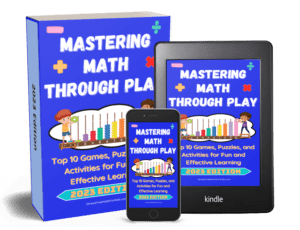My passion for teaching math began with my training as a dyslexia specialist, where I learned the current brain research on teaching reading and wondered how the current brain research on math would be similar or different. When I learned that up to a full 20 percent of children use completely different neural pathways to read, I wanted to know how those same children learned math.
I recently attended a couple of different workshops on brain research by Lori Gracey as part of an education conference, which of course led to my own reading and research. Here are some of the more interesting concepts. I have linked to the research as much as possible.
Numeracy is natural.
“Numeracy is actually an innate skill inherent in humans from birth and enhanced through formal education. ” (The Neuroscience of Mathematical Cognition and Learning)
My very first article when I started this website was called What Is Most Important in Teaching Math? and was about helping kids change their mindset toward math by realizing there is no such thing as being “not a math person”- everyone uses math every day in everything that they do!

I’ll be writing a whole separate post on Jo Boaler’s research and her book Mathematical Mindsets. (Her website youcubed is a great source for growth mindset activities.) Here is another great blog on Mindset and Brain Science.
Motivation is the key factor.
Motivation is the key factor in whether someone learns something or not.
Low dopamine= low motivation. Dopamine plays an important role in working memory and boosts spatial learning. It may play a critical role in episodic memory

Natural ways to increase dopamine are:
eat lots of protein
less saturated fat
exercise often
get enough sleep (Sleep deprivation reduces the brain’s ability to learn by up to 40%.)
get enough sunlight
listen to uplifting instrumental music
meditation (one hour leads to a 64 % increase that can last 24 hours, source)
Play, humor, laughter
Provide opportunities to pause and realize you are on the right path
Celebrate completion
Higher endorphins also lead to higher dopamine. Try these things:
Create music and art
Spritz lavender
Eat your favorite food
Exercise at least 3 times a week for 45 minutes
Laughter
Eat dark chocolate— Magnesium reduces stress
The use of innovative teaching methods can foster students’ motivation to overcome barriers in math learning (Equations and Inequalities: Making Mathematics Accessible to All).
Moderate stress is beneficial for learning but both boredom and excessive stress are detrimental to learning. Fear hinders learning. Active learning of any kind takes advantage of processes that stimulate multiple neural connections in the brain and promote memory.
We need to work together.
The brain is a social organ and students of all ages need collaborative activities. People working together need to be enriched, energized and empowered by being part of a shared human experience. This generates power and purpose. Remember that connection has to come before collaboration. Positive relationships create safe spaces for learning. Oxytocin is the hormone that promotes trust and bonding, reduces stress, enhances contentment and security. You release oxytocin when others show trust in you. High oxytocin causes people to work harder to achieve the goals of the group. (interesting fact: greeting students at the classroom door increases engagement by 20 percent and decreases behavior issues by 9 percent.)
When we learn we build connections in our brain.
Learning involves changing the brain. There is a physical change in the brain when we learn a new concept. However this is not adding new brain cells! You are born with all the brain cells you will ever have. Throughout childhood they will grow bigger and heavier. What learning does is make the cells add connections, or synapses!
I found this paragraph from Science Daily to put it best. “The process of educating a child is physically changing the brain,” said Jason Yeatman, an assistant professor in both the UW Department of Speech and Hearing Sciences and the Institute for Learning & Brain Sciences (I-LABS). “We were able to detect changes in brain connections within just a few weeks of beginning the intervention program. It’s underappreciated that teachers are brain engineers who help kids build new brain circuits for important academic skills…”
Simple math exercises stimulate activity in both the left and right areas of the frontal lobe of the brain. Three different regions of the brain were identified by a neuroscience lab at Stanford University as predicting improvement in math learning. “It’s not just a math part of the brain, it’s a network of regions… and success in math is related to how well those regions form a network.” (research published in the Journal of Neuroscience, August 2015, lead author Tanya Evans.)
“It’s about multiple regions working in concert. The better they work in concert, the more essentially they speak to each other , the stronger the gains in numerical abilities.” (Daniel Ansari, neuroscientist at the University of Western Ontario) The neural pathways that are used the most often get stronger and more well established. Sharing something new you have learned also reinforces new neural pathways. (Try having students share something they learned while doing something silly such as standing like a flamingo to add the aspect of humor and laughter.)
Serotonin
Serotonin gives confidence, self esteem, sense of purpose. It regulates and modulates mood, sleep, anxiety, and appetite. It promotes patience and ability to cope, and contributes to learning speed.
Natural ways to increase serotonin:
Remember happy events
Get sunlight
Exercise
Eat salmon, chicken, turkey, eggs, spinach, seeds, nuts
Physical touch
Gratitude journal/reflections
Acknowledge hard work
Recognize achievements
Best practices for encouraging learning
We take in information better when it’s visual. The brain uses 50 percent of its resources on vision. We learn new information best when it is interwoven and connected to something we already know. (source for both of these:)
What the brain really craves is novelty. Being exposed to new ideas replaces dopamine. The brain has a short attention span and needs the challenge of fresh and unusual stimuli. It is a code cracking machine. Variation in activities matters. Reestablish attention every 5- 10 minutes.
Dopamine is also released from authentic praise. One simple feedback phrase can boost student effort by 40 percent. (That specific phrase is I’m giving you these comments because I have very high expectations and I know that you can reach them.)
There is such a thing as cognitive overload. Decide what is really important to teach. There is too much in the standards to actually fully cover it all!
Research shows we can’t actually multitask. One of the things will be a distraction to the other. Music benefits creative activity such as art but otherwise should not be played while working- silence is better. Also don’t put too much on the walls. Heavy decorations are overwhelming and impair attention and memory. The only things up should be things that help with learning.
Emphasize big picture and let students discover details. Start with the major concept and return to it repeatedly.
The best way to learn is to teach someone else. Get students to create and ask the questions. PBL done correctly is very effective. Guessing actually leads to higher recall rates. Reflection on your own learning process improves intelligence and not just achievement.


